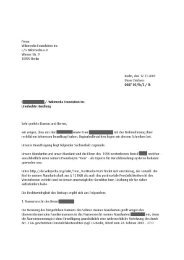Proceedings
Proceedings
Proceedings
You also want an ePaper? Increase the reach of your titles
YUMPU automatically turns print PDFs into web optimized ePapers that Google loves.
COLLATERAL DAMAGE<br />
and is hostile to innocent users. This has in turn led to a wave of anti-antispam<br />
measures that stop the bogus bounces, and some users now reject bounces<br />
altogether, further reducing the reliability of e-mail communication.<br />
People who really trust their filters then simply discard messages classified<br />
as junk e-mail without any notice. But this approach is rarely appropriate.<br />
Putting suspected junk messages in a quarantine area for manual inspection<br />
works reasonably well on balance, but is hardly manageable in larger organizations<br />
[1]. There are also significant privacy concerns with this approach.<br />
What is rarely considered is that the two problematic factors in the old<br />
days approach should simply be fixed. First, SMTP clients that time out too<br />
fast: Fixing the actual e-mail client programs would be hard to achieve because<br />
that end of the bargain is influenced by unresponsive manufacturers and inexperienced<br />
users. Most of the time, however, the client in these transactions is<br />
another MTA program, which can easily be reconfigured to support longer timeouts.<br />
Second, checking the message on the receiving host takes too long: The<br />
internals of many of the e-mail filtering applications are quite frankly a mess.<br />
Assembled during a period where new filtering techniques appeared by the week,<br />
they lack proper design, are overloaded with features, and consequently do not<br />
perform well. More robust and streamlined implementations could easily outperform<br />
the toolkits of today to make e-mail filtering at the point of delivery<br />
possible again.<br />
2.3 Greylisting<br />
The amazing fact about greylisting is that it still works at all. Greylisting relies<br />
on the fact that spamming software and in particular mailing software installed<br />
on zombies, does not retry sending after receiving a temporary failure reply from<br />
the recipient. Greylisting is extremely effective; in my experience it can block<br />
between 80% and 90% of all junk e-mail. The reason why so few spamming<br />
software makers have reacted and added a sending queue to their software can<br />
only be assumed to be that so few sites use greylisting.<br />
The problem with greylisting is not so much that is hinders the e-mail<br />
traffic—the delay is usually about 15 minutes and the additional traffic is<br />
minimal—but that it’s easy to get the configuration wrong:<br />
• The concept sounding so simple, many of the early greylisting implementations<br />
are hack jobs that break easily and are full of security holes.<br />
• Distributing the mail server load on more than one machine causes various<br />
kinds of problems:<br />
– If it is done on the sender side, each new delivery attempt will appear<br />
to come from a different IP address which will again be greylisted.<br />
This can usually be circumvented by greylisting not the IP address<br />
but, say, the entire class C network.<br />
– If the load spreading is done on the server side, it is important that<br />
the greylisting database is shared between all nodes, otherwise the<br />
client is greylisted again if the next delivery attempt is serviced by a<br />
different node.<br />
4<br />
67 |






